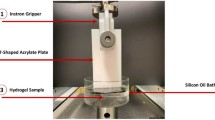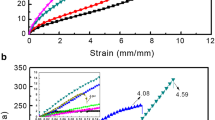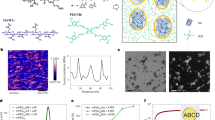Abstract
Hydrogels, bearing microstructural semblance to biological tissues, are prime candidates for translation replacement materials. Among them, double network (DN) hydrogels are at the forefront with their superior mechanical properties compared to conventional single network hydrogels. However, the functional design of the microstructure to control mechanical and tribological performance still poses a challenge. Here, hydrogels composed of physically crosslinked agarose and chemically crosslinked poly(acrylamide) were studied by spectroscopy, dynamic light scattering, atomic force microscopy and rheology. A viable hydrogel formed with the lowest acrylamide concentration, but the loose PAAm network did not reinforce the agarose network. Increasing the monomer and crosslinker concentration led to fast gelation of the second network, yielding poorly interconnected acrylamide-rich domains within the agarose network, and a weak and heterogenous hydrogel. Reducing the crosslinking degree to the half slowed down gelation, which favored the formation of an interpenetrating PAAm network, affording a two-fold increase in strength. While the adhesion of the investigated hydrogels is remarkably dictated and reduced by agarose, their frictional characteristics are highly sensitive to the composition. Importantly, friction can be modulated by varying the imbibed fluid.









Similar content being viewed by others
References
Zhang, Y.S., Khademhosseini, A.: Advances in engineering hydrogels. Science (2017). https://doi.org/10.1126/science.aaf3627
Hoffman, A.S.: Hydrogels for biomedical applications. Adv. Drug Deliv. Rev. 64, 18–23 (2012)
Brand, R.A.: Joint contact stress: a reasonable surrogate for biological processes? Iowa Orthop. J. 25, 82–94 (2005)
Gong, J.P., Katsuyama, Y., Kurokawa, T., Osada, Y.: Double-network hydrogels with extremely high mechanical strength. Adv. Mater. 15, 1155–1158 (2003)
Wang, M.X., Yang, C.H., Liu, Z.Q., Zhou, J., Xu, F., Suo, Z., et al.: Tough photoluminescent hydrogels doped with lanthanide. Macromol. Rapid Commun. 36, 465–471 (2015)
Lake, G.J., Thomas, A.G.: The strength of highly elastic materials. Proc. R. Soc. Lond. A 300, 108–119 (1967)
Sun, J.Y., Zhao, X., Illeperuma, W.R., Chaudhuri, O., Oh, K.H., Mooney, D.J., et al.: Highly stretchable and tough hydrogels. Nature 489, 133–136 (2012)
Xu, X., Jerca, V.V., Hoogenboom, R.: Bioinspired double network hydrogels: from covalent double network hydrogels via hybrid double network hydrogels to physical double network hydrogels. Mater. Horiz. 8, 1173–1188 (2021)
Haque, M.A., Kurokawa, T., Gong, J.P.: Super tough double network hydrogels and their application as biomaterials. Polymer 53, 1805–1822 (2012)
Gao, G., Du, G., Sun, Y., Fu, J.: Self-healable, tough, and ultrastretchable nanocomposite hydrogels based on reversible polyacrylamide/montmorillonite adsorption. ACS Appl. Mater. Interfaces 7, 5029–5037 (2015)
Lin, S., Cao, C., Wang, Q., Gonzalez, M., Dolbow, J.E., Zhao, X.: Design of stiff, tough and stretchy hydrogel composites via nanoscale hybrid crosslinking and macroscale fiber reinforcement. Soft Matter 10, 7519–7527 (2014)
Ekblad, T., Bergstrom, G., Ederth, T., Conlan, S.L., Mutton, R., Clare, A.S., et al.: Poly(ethylene glycol)-containing hydrogel surfaces for antifouling applications in marine and freshwater environments. Biomacromolecules 9, 2775–2783 (2008)
Tsukeshiba, H., Huang, M., Na, Y.H., Kurokawa, T., Kuwabara, R., Tanaka, Y., et al.: Effect of polymer entanglement on the toughening of double network hydrogels. J. Phys. Chem. B 109, 16304–16309 (2005)
Nakajima, T., Furukawa, H., Tanaka, Y., Kurokawa, T., Osada, Y., Gong, J.P.: True chemical structure of double network hydrogels. Macromolecules 42, 2184–2189 (2009)
Es-haghi, S.S., Leonov, A.I., Weiss, R.A.: On the necking phenomenon in pseudo-semi-interpenetrating double-network hydrogels. Macromolecules 46, 6203–6208 (2013)
Arakaki, K., Kitamura, N., Fujiki, H., Kurokawa, T., Iwamoto, M., Ueno, M., et al.: Artificial cartilage made from a novel double-network hydrogel: in vivo effects on the normal cartilage and ex vivo evaluation of the friction property. J. Biomed. Mater. Res. A 93, 1160–1168 (2010)
Gu, Z., Huang, K., Luo, Y., Zhang, L., Kuang, T., Chen, Z., et al.: Double network hydrogel for tissue engineering. Wiley Interdiscip. Rev. Nanomed. Nanobiotechnol. 10, e1520 (2018)
Nakajima, T., Gong, J.P.: Double-Network Hydrogels: Soft and Tough IPN, pp. 1–6. Springer, Berlin, Heidelberg (2013)
Chen, Q., Zhu, L., Huang, L., Chen, H., Xu, K., Tan, Y., et al.: Fracture of the physically cross-linked first network in hybrid double network hydrogels. Macromolecules 47, 2140–2148 (2014)
Shi, Y., Li, J., Xiong, D., Li, L., Liu, Q.: Mechanical and tribological behaviors of PVA/PAAm double network hydrogels under varied strains as cartilage replacement. J. Appl. Polym. Sci. 138, 50226 (2020)
Chen, Q., Zhu, L., Chen, H., Yan, H., Huang, L., Yang, J., et al.: A novel design strategy for fully physically linked double network hydrogels with tough, fatigue resistant, and self-healing properties. Adv. Func. Mater. 25, 1598–1607 (2015)
Lin, T., Bai, Q., Peng, J., Xu, L., Li, J., Zhai, M.: One-step radiation synthesis of agarose/polyacrylamide double-network hydrogel with extremely excellent mechanical properties. Carbohydr. Polym. 200, 72–81 (2018)
Cho, M.K., Singu, B.S., Na, Y.H., Yoon, K.R.: Fabrication and characterization of double-network agarose/polyacrylamide nanofibers by electrospinning. J. Appl. Polym. Sci. 133, 42914 (2016)
Zhang, Y., Zhou, S., Zhang, L., Yan, Q., Mao, L., Wu, Y., et al.: Pre-Stretched double network polymer films based on agarose and polyacrylamide with sensitive humidity-responsive deformation, shape memory, and self-healing properties. Macromol. Chem. Phys. 221, 1900518 (2020)
Mredha, M.T.I., Kitamura, N., Nonoyama, T., Wada, S., Goto, K., Zhang, X., et al.: Anisotropic tough double network hydrogel from fish collagen and its spontaneous in vivo bonding to bone. Biomaterials 132, 85–95 (2017)
Yasuda, K., Kitamura, N., Gong, J.P., Arakaki, K., Kwon, H.J., Onodera, S., et al.: A novel double-network hydrogel induces spontaneous articular cartilage regeneration in vivo in a large osteochondral defect. Macromol. Biosci. 9, 307–316 (2009)
Li, X., Wu, C., Yang, Q., Long, S., Wu, C.: Low-velocity super-lubrication of sodium-alginate/polyacrylamide ionic-covalent hybrid double-network hydrogels. Soft Matter 11, 3022–3033 (2015)
Yu, F., Cui, T., Yang, C., Dai, X., Ma, J.: kappa-Carrageenan/Sodium alginate double-network hydrogel with enhanced mechanical properties, anti-swelling, and adsorption capacity. Chemosphere 237, 124417 (2019)
Kaneko, D., Tada, T., Kurokawa, T., Gong, J.P., Osada, Y.: Mechanically strong hydrogels with ultra-low frictional coefficients. Adv. Mater. 17, 535–538 (2005)
Katta, J.K., Marcolongo, M., Lowman, A., Mansmann, K.A.: Friction and wear behavior of poly(vinyl alcohol)/poly(vinyl pyrrolidone) hydrogels for articular cartilage replacement. J. Biomed. Mater. Res. A 83, 471–479 (2007)
Zhang, K., Simic, R., Yan, W., Spencer, N.D.: Creating an interface: rendering a double-network hydrogel lubricious via spontaneous delamination. ACS Appl. Mater. Interfaces 11, 25427–25435 (2019)
Bonyadi, S.Z., Demott, C.J., Grunlan, M.A., Dunn, A.C.: Cartilage-like tribological performance of charged double network hydrogels. J. Mech. Behav. Biomed. Mater. 114, 104202 (2021)
Shoaib, T., Espinosa-Marzal, R.M.: Influence of loading conditions and temperature on static friction and contact aging of hydrogels with modulated microstructures. ACS Appl. Mater. Interfaces 11, 42722–42733 (2019)
Shoaib, T., Espinosa-Marzal, R.M.: Insight into the viscous and adhesive contributions to hydrogel friction. Tribol. Lett. 66, 96 (2018)
Shoaib, T., Yuh, C., Wimmer, M.A., Schmid, T.M., Espinosa-Marzal, R.M.: Nanoscale insight into the degradation mechanisms of the cartilage articulating surface preceding OA. Biomater. Sci. 8, 3944–3955 (2020)
Joosten, J.G.H., McCarthy, J.L., Pusey, P.N.: Dynamic and static light scattering by aqueous polyacrylamide gels. Macromolecules 24, 6690–6699 (2002)
Siegert, A.J.F.: On the fluctuations in signals returned by many independently moving scatterers. Radiation Laboratory, Massachusetts Institute of Technology, Cambridge, MA (1943)
Seiffert, S.: Scattering perspectives on nanostructural inhomogeneity in polymer network gels. Prog. Polym. Sci. 66, 1–21 (2017)
Cannara, R.J., Eglin, M., Carpick, R.W.: Lateral force calibration in atomic force microscopy: a new lateral force calibration method and general guidelines for optimization. Rev. Sci. Instrum. 77, 053701 (2006)
Johnson, K.L., Kendall, K., Roberts, A.D.: Surface energy and the contact of elastic solids. Proc. R. Soc. A 324, 301–313 (1997)
Hertz, H.: Ueber die Berührung fester elastischer Körper. 156–171 (1882)
Gombert, Y., Simič, R., Roncoroni, F., Dübner, M., Geue, T., Spencer, N.D.: Structuring hydrogel surfaces for tribology. Adv. Mater. Interfaces 6, 1901320 (2019)
Priya, M.V., Kumar, R.A., Sivashanmugam, A., Nair, S.V., Jayakumar, R.: Injectable amorphous chitin-agarose composite hydrogels for biomedical applications. J. Funct. Biomater. 6, 849–862 (2015)
Hu, Z., Hong, P.Z., Li, S.D., Yang, L., Xie, J.Y.: Study on the preparation of quaternized chitosan/agarose microspheres for berbamine delivery. J. Polym. Mater. 29, 361–370 (2012)
Godwin Uranta, K., Rezaei-Gomari, S., Russell, P., Hamad, F.: Studying the effectiveness of polyacrylamide (PAM) application in hydrocarbon reservoirs at different operational conditions. Energies 11, 2201 (2018)
Wang, F.C., Feve, M., Lam, T.M., Pascault, J.P.: FTIR analysis of hydrogen bonding in amorphous linear aromatic polyurethanes. I. Influence of temperature. J. Polym. Sci. Part B: Polym. Phys. 32, 1305–1313 (1994)
Dai, B., Matsukawa, S.: Elucidation of gelation mechanism and molecular interactions of agarose in solution by 1H NMR. Carbohydr. Res. 365, 38–45 (2013)
De Gennes, P.G.: Scaling concepts in polymer physics. Cornell University Press, Ithaca and London (1979)
Shoaib, T., Carmichael, A., Corman, R.E., Shen, Y., Nguyen, T.H., Ewoldt, R.H., et al.: Self-adaptive hydrogels to mineralization. Soft Matter 13, 5469–5480 (2017)
Delavoipiere, J., Tran, Y., Verneuil, E., Heurtefeu, B., Hui, C.Y., Chateauminois, A.: Friction of poroelastic contacts with thin hydrogel films. Langmuir 34, 9617–9626 (2018)
Reale, E.R., Dunn, A.C.: Poroelasticity-driven lubrication in hydrogel interfaces. Soft Matter 13, 428–435 (2017)
Watase, M., Nishinari, K.: Thermal and rheological properties of agarose-dimethyl sulfoxide-water gels. Polym. J. 20, 1125–1133 (1988)
Deguchi, S., Lindman, B.: Novel approach for the synthesis of hydrophobe modified polyacrylamide. Direct N-alkylation of polyacrylamide in dimethyl sulfoxide. Polymer 40, 7163–7165 (1999)
Brayton, C.F.: Dimethyl sulfoxide (DMSO): a review. Cornell Vet. 76, 61–90 (1986)
Kirchner, B., Reiher, M.: The secret of dimethyl sulfoxide-water mixtures. A quantum chemical study of 1DMSO-nwater clusters. J. Am. Chem. Soc. 124, 6206–6215 (2002)
Murat Ozmen, M., Okay, O.: Formation of macroporous poly(acrylamide) hydrogels in DMSO/water mixture: transition from cryogelation to phase separation copolymerization. React. Funct. Polym. 68, 1467–1475 (2008)
Ozmen, M.M., Dinu, M.V., Okay, O.: Preparation of macroporous poly(acrylamide) hydrogels in DMSO/water mixture at subzero temperatures. Polym. Bull. 60, 169–180 (2007)
LeBel, R.G., Goring, D.A.I.: Density, viscosity, refractive index, and hygroscopicity of mixtures of water and dimethyl sulfoxide. J. Chem. Eng. Data 7, 100–101 (2002)
Rudge, R.E.D., Scholten, E., Dijksman, J.A.: Natural and induced surface roughness determine frictional regimes in hydrogel pairs. Tribol. Int. 141, 105903 (2020)
Baumberger, T., Caroli, C., Ronsin, O.: Self-healing slip pulses along a gel/glass interface. Phys. Rev. Lett. 88, 075509 (2002)
Hayashi, A., Kanzaki, T.: Swelling of agarose gel and its related changes. Food Hydrocolloids 1, 317–325 (1987)
Xiong, J.Y., Narayanan, J., Liu, X.Y., Chong, T.K., Chen, S.B., Chung, T.S.: Topology evolution and gelation mechanism of agarose gel. J. Phys. Chem. B 109, 5638–5643 (2005)
Gombert, Y., Roncoroni, F., Sanchez-Ferrer, A., Spencer, N.D.: The hierarchical bulk molecular structure of poly(acrylamide) hydrogels: beyond the fishing net. Soft Matter 16, 9789–9798 (2020)
de Gennes, P.-G.: Effect of cross-links on a mixture of polymers. J. Physique Lett. 40, 69–72 (1979)
Nakajima, T., Furukawa, H., Tanaka, Y., Kurokawa, T., Gong, J.P.: Effect of void structure on the toughness of double network hydrogels. J. Polym. Sci. Part B: Polym. Phys. 49, 1246–1254 (2011)
Pitenis, A.A., Sawyer, W.G.: Lubricity of high water content aqueous gels. Tribol. Lett. 66(3), 1–7 (2018)
Shoaib, T., Heintz, J., Lopez-Berganza, J.A., Muro-Barrios, R., Egner, S.A., Espinosa-Marzal, R.M.: Stick-slip friction reveals hydrogel lubrication mechanisms. Langmuir 34, 756–765 (2018)
Cuccia, N.L., Pothineni, S., Wu, B., Mendez Harper, J., Burton, J.C.: Pore-size dependence and slow relaxation of hydrogel friction on smooth surfaces. Proc. Natl. Acad. Sci. USA 117, 11247–11256 (2020)
McGhee, E.O., Chau, A.L., Cavanaugh, M.C., Rosa, J.G., Davidson, C.L.G., Kim, J., et al.: Amphiphilic gel lubrication and the solvophilic transition. Biotribology 26, 100170 (2021)
Chen, Q., Wei, D., Chen, H., Zhu, L., Jiao, C., Liu, G., et al.: Simultaneous enhancement of stiffness and toughness in hybrid double-network hydrogels via the first physically linked network. Macromolecules 48, 8003–8010 (2015)
Acknowledgements
We acknowledge the Materials Research Laboratory (MRL) at UIUC for providing the DLS facility.
Funding
This material is based upon work supported by the National Science Foundation under Grant No. CMMI-1761696.
Author information
Authors and Affiliations
Contributions
All authors contributed to the study conception and design. Material preparation and data collection were performed by Tooba Shoaib and Paige Prendergast, and analysis was carried out by all authors. The first draft of the manuscript was written by Tooba Shoaib and all authors commented on previous versions of the manuscript. All authors read and approved the final manuscript.
Corresponding author
Ethics declarations
Conflict of interest
The authors have no relevant financial or non-financial interests to disclose.
Additional information
Publisher's Note
Springer Nature remains neutral with regard to jurisdictional claims in published maps and institutional affiliations.
Supplementary Information
Below is the link to the electronic supplementary material.
Rights and permissions
About this article
Cite this article
Shoaib, T., Prendergast, P. & Espinosa-Marzal, R.M. Compositional Tuning Reveals a Pathway to Achieve a Strong and Lubricious Double Network in Agarose-Polyacrylamide Hydrogels. Tribol Lett 70, 71 (2022). https://doi.org/10.1007/s11249-022-01604-4
Received:
Accepted:
Published:
DOI: https://doi.org/10.1007/s11249-022-01604-4




